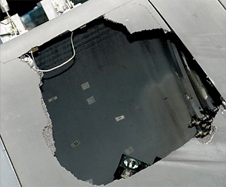November 24, 2009 Vol. 2, Issue 11
The ballistic impact testing conducted at Glenn Research Center in the wake of the Columbia accident provided new insights about the accident and the vulnerabilities of the space shuttle system, according to structural engineer Matt Melis.

Foam strike testing of fiberglass paneling conducted at a Southwest Research Institute facility. Photo Credit: CAIB Report
For over five years, Melis has been presenting the story of the Columbia accident and the work done at the Glenn Ballistic Impact Laboratory as part of NASA’s Return to Flight efforts. He traveled to NASA Headquarters in October 2009 to share his experience with the Office of the Chief Engineer and the Academy of Program/Project & Engineering Leadership.
Melis passed around a lunch-tray sized sheet from an external tank, a chunk of the foam that protects the External Tank, and a piece of the shuttle orbiter’s Reinforced Carbon-Carbon (RCC) paneling, and explained the sequence of events leading up to Columbia’s reentry and the aftermath. The engineering data to assess the foam strike on Columbia simply did not exist to enable NASA to properly identify the threat to Columbia and its crew, said Melis. He then presented numerous high-speed impact videos of the testing conducted at Glenn to help determine what happened. Citing the cliché that a picture is worth a thousand words, Melis said, “Well, a movie is worth ten thousand words.”

Impact hole in Panel 8 of RCC material from foam strike. Photo Credit: CAIB Report
Frame after frame, cylinders of foam, weighing no more than a sheet of paper, moving at speeds of 500 mph (200 mph less than the calculated speeds for Columbia) splintered RCC-panels with surprising ease. These moving images animated the well-known still-shots from the Columbia Accident Investigation Board report, reinforcing an important lesson learned for all engineers: you never know all of the design flaws lurking in your system, so be vigilant.
Melis has shared this story hundreds of times with audiences ranging from experts to students. “I was tasked to represent the NASA Glenn Ballistic Impact Lab to the Orbiter Program Office and demonstrate the value of our experimental and computational capabilities to both the accident investigation and Return to Flight,” Melis said. Near the completion of the accident investigation, he briefed Woodrow Whitlow, now the Glenn Research Center Director, who arranged for Melis to present at an all-hands gathering at Glenn. “The positive feedback from that briefing encouraged me present to other audiences. I understood, at that point, that it would be highly worthwhile to many individuals to learn the lessons from Columbia and the Return to Flight program,” said Melis. “The rest of it is history.”





